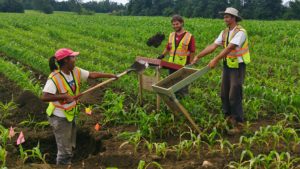
If an archaeological site with cultural heritage significance is found during the Stage 2 then a Stage 3 site-specific assessment must be conducted. The intent of a Stage 3 is to determine the size of the site, identify the site limits, and evaluate the cultural heritage value of the area in question. If the site was found during a Stage 2 pedestrian survey then it may require re-ploughing to allow our archaeologists to conduct a Controlled Surface Collection (CSP). During a CSP, individual locations of artifacts and artifact clusters are mapped using a Total Station. This is followed by a systematic excavation of one metre square test units on a five to ten metre grid.
The data recovered during the course of a Stage 3 excavation are analyzed by ASI’s team of material culture analysts. The use of custom databases for cataloguing and analyzing finds allows this within a relatively short period of time, with great flexibility of approach and a minimum of expense.
A Stage 3 assessment report is generated that presents our data and will recommend either that: a) the site in question has further heritage significance and must be subject to a Stage 4 mitigation (either through protection and avoidance or by excavation) or b) the site has no further cultural heritage value and does not require further assessment. This report will be submitted the report to the MHSTCI for review and concurrence.
